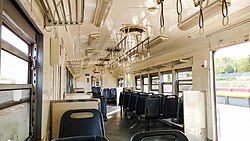| Toshiba EMU | |
|---|---|
 Toshiba train in Remedios de Escalada (2020) | |
 Downgraded interior (2017) | |
| In service | 1985 - Present |
| Manufacturer | |
| Assembly |
|
| Formation |
|
| Specifications | |
| Car length | 25 m (82 ft 0 in) |
| Doors | 3 per side |
| Maximum speed | 120 km/h (75 mph) |
| Electric system(s) | 25 kV 50 Hz AC overhead line |
| Current collector(s) | Pantograph (AC) |
| Braking system(s) | air |
| Safety system(s) | ATS |
| Track gauge | 1,676 mm (5 ft 6 in) |
The Toshiba EMU is an electric multiple unit train model used in the Roca Line in the Southern Buenos Aires Metropolitan Area, Argentina.
The trains operate in sets of two semi-permanently coupled units, formed by: four motor cabin cars (two used for conduction, and two unused in the middle of the train) named as M (for motor), two trailer cars (named as R, remolque) and a "trailer prime" (named as R'), an extra car which is not factory original to this trains, but had to be added after-hands to attend the increase in demand of the Roca Line. Overall, the Toshiba sets have seven cars, but circulation is interrupted in the middle of the set by the conduction cabins, in an M-R-M/M-R-R'-M consist.[1]
Construction began in 1984 in Japan by a company consortium led by Nippon Sharyo and Toshiba, with the participation of Tokyu Car, Kawasaki, Kinki Sharyo, Toshiba and Hitachi.[1][2][3] Toshiba was in charge of the motor equipment, so the trains started being named after that company.[4] The first 102 cars were built in the Asian nation and, in 1985, Fabricaciones Militares (Military Works) built 54 in Argentina. An extra 28 "trailer prime" cars were built by Materfer to increase the trains capacity.[1] This model resembles the Japanese Odakyu 9000 series, also manufactured by Tokyu Car and Kawasaki.
These were the first electric trains in Argentina to operate under 25 kV alternate current, and to use the ATS safety system.[5] They replaced push-pull diesel trains built by Materfer in the Roca Line Ezeiza and Glew branches.[5]
Since 2016, some of the trains were replaced by newer CSR units, but an approximate 20 Toshiba trainsets still operate daily.[6]
- ^ a b c Andrés J. Bilstein (16 March 2018). "Los eléctricos japoneses del Roca". Portal de Trenes (in Latin American Spanish). Archived from the original on 16 July 2018.
- ^ Zommer, Laura (27 April 2014). "Detrás del discurso. Nuevos trenes y olvidos de la historia" [Behind the speech. New trains and forgotten history]. La Nación (in Latin American Spanish).
- ^ "アルゼンチンで活躍する日車製電車". Nippon Sharyo (in Japanese).
- ^ enelSubte.com (2017-07-28). "El Roca y la electrificación interminable". enelSubte.com (in Latin American Spanish). Retrieved 2020-09-01.
- ^ a b "Documental de la obra de Electrificación de las Líneas Urbanas y Suburbanas del Ferrocarril General Roca en la Argentina" [Documentary on the Electrification works of the Urban and Suburban Lines in the General Roca Railway in Argentina] (video). YouTube (in Latin American Spanish). Ferrocarriles Argentinos. 1985.
- ^ "Resolución 1382-E/2017". Argentina.gob.ar (in Spanish). Ministry of Transport of Argentina. 4 January 2018. Retrieved 2020-08-31.
